Bibliometric Analysis on the Implementation of Evidence-Based Practices through Building Effective Systems
Abstract
1. Introduction
- RQ1: How has the publication of articles related to system building from the implementation of evidence-based practices in early intervention evolved?
- RQ2: Which authors have produced the most publications related to system building since the implementation of evidence-based practices in early intervention, and which of these authors’ work is most mentioned?
- RQ3: Which journals have produced the most research on the topic of building systems through the implementation of evidence-based practices in early intervention, and what are their Impact Factors?
- RQ4: What co-authorship networks, co-citations, and co-words are associated with studies detailing system building from the implementation of evidence-based practices in early intervention?
- RQ5: What are the main topics to be explored in this research?
2. Materials and Methods
2.1. Data Collection
2.2. Bibliometric Analysis
3. Results
3.1. Basic Indicators
3.1.1. Years
3.1.2. Authors
3.1.3. Countries
3.1.4. Journals
3.1.5. Most Common Keywords
3.2. Co-Citation Analysis
3.2.1. Co-Authorship
3.2.2. Co-Word Analysis
3.3. Thematic Analysis
3.3.1. Bibliographic Coupling
Blue Cluster (42 Citations, Six Articles): Family Coaching and Capacity Building
Purple Cluster (284 Citations, 12 Papers): Professional Development
Red Cluster (62 Citations, 14 Papers): Family-Centered Practices
Green Cluster (275 Citations, 17 Papers): Early Childhood Special Education
3.3.2. Strategic Thematic Analysis
4. Discussion
5. Theoretical and Practical Implications of this Study
6. Conclusions
7. Limitations and Future Research
Author Contributions
Funding
Institutional Review Board Statement
Informed Consent Statement
Data Availability Statement
Conflicts of Interest
References
- Argente-Tormo, J.; Martínez-Rico, G.; Cañadas, M.; Bañuls, F. Construyendo Sistemas Eficaces Para La Implementación de Prácticas Recomendadas En Atención Temprana. HUMAN REVIEW Int. Humanit. Rev. Rev. Int. Humanid. 2022, 11, 1–12. [Google Scholar] [CrossRef]
- Hebbeler, K.; Spiker, D.; Kahn, L. Individuals with Disabilities Education Act’s Early Childhood Programs: Powerful Vision and Pesky Details. Top. Early Child. Spec. Educ. 2012, 31, 199–207. [Google Scholar] [CrossRef]
- De Andres Viloria, C.; Guinea, C.L. La Atención a la Familia en A.T.: Retos Actuales. Psicol. Educ. 2012, 18, 123–133. [Google Scholar] [CrossRef]
- Halle, T.; Metz, A.; Martinez-Beck, I. Applying Implementation Science in Early Childhood Programs and Systems; Paul, H., Ed.; Brookes Publishing Company: Baltimore, MD, USA, 2013. [Google Scholar]
- Mora, C.T.E.; Pérez, M.C.; Martínez-Rico, G.; Grau, P.G. Fases y Pasos En La Implementación de Prácticas Recomendadas En Atención Temprana. Siglo Cero Rev. Española Sobre Discapac. Intelect. 2021, 52, 37–57. [Google Scholar] [CrossRef]
- Kasprzak, C.; Hebbeler, K.; Spiker, D.; McCullough, K.; Lucas, A.; Walsh, S.; Swett, J.; Smith, B.J.; Kelley, G.; Whaley, K.T.; et al. A State System Framework for High-Quality Early Intervention and Early Childhood Special Education. Top. Early Child. Spec. Educ. 2020, 40, 97–109. [Google Scholar] [CrossRef]
- Bertram, R.; Blase, K.; Shern, D.; Shea, P.; Fixsen, D. Policy Research Brief: Implementation Opportunities and Challenges for Prevention and Promotion Initiatives; National Association of State Mental Health Program Directors (NASMHPD): Alexandria, VA, USA, 2011. [Google Scholar]
- Bricker, D.D.; Felimban, H.S.; Lin, F.Y.; Stegenga, S.M.; Storie, S.O. A Proposed Framework for Enhancing Collaboration in Early Intervention/Early Childhood Special Education. Top. Early Child. Spec. Educ. 2022, 41, 240–252. [Google Scholar] [CrossRef]
- Bruder, M.B.; Dunst, C.J.; Mogro-Wilson, C. Child Factors Associated with Enrollment in Part C Early Intervention among Children Adopted from China. J. Early Interv. 2009, 32, 54–67. [Google Scholar] [CrossRef]
- Bartolacci, F.; Caputo, A.; Soverchia, M. Sustainability and Financial Performance of Small and Medium Sized Enterprises: A Bibliometric and Systematic Literature Review. Bus. Strategy Environ. 2020, 29, 1297–1309. [Google Scholar] [CrossRef]
- González-García, R.J.; Martínez-Rico, G.; Escorcia-Mora, C.; García-Grau, P. A Bibliometric Study on the Social Validity of Telepractice in Autism Spectrum Disorder. Int. J. Environ. Res. Public Health 2023, 20, 419. [Google Scholar] [CrossRef]
- Schalock, R.L.; Verdugo, M.A.; Gomez, L.E. Evidence-Based Practices in the Field of Intellectual and Developmental Disabilities: An International Consensus Approach. Eval. Program Plan. 2011, 34, 273–282. [Google Scholar] [CrossRef]
- Bruder, M.B.; Dunst, C.; Maude, S.P.; Schnurr, M.; Van Polen, A.; Frolek Clark, G.; Winslow, A.; Gethmann, D. Practitioner Appraisals of Their Desired and Current Use of the 2014 Division for Early Childhood Recommended Practices. J. Early Interv. 2020, 42, 259–274. [Google Scholar] [CrossRef]
- Pilelienė, L.; Alsharif, A.H.; Alharbi, I.B. Scientometric analysis of scientific literature on neuromarketing tools in advertising. Balt. J. Econ. Stud. 2022, 8, 1–12. [Google Scholar] [CrossRef]
- Alsharif, A.H.; Md Salleh, N.Z.; Baharun, R.; Rami Hashem, E.A. Neuromarketing Research in the Last Five Years: A Bibliometric Analysis. Cogent Bus. Manag. 2021, 8, 1978620. [Google Scholar] [CrossRef]
- Alsharif, A.H.; Salleh, N.Z.M.; Baharun, R.; Abuhassna, H.; Hashem, A.R. A Global Research Trends of Neuromarketing: 2015–2020. Rev. Comun. 2022, 21, 15–32. [Google Scholar] [CrossRef]
- Ali, J.; Jusoh, A.; Idris, N.; Abbas, A.F.; Alsharif, A.H. Everything Is Going Electronic, so Do Services and Service Quality: Bibliometric Analysis of E-Services and E-Service Quality. IJIM 2021, 15, 148–167. [Google Scholar] [CrossRef]
- González-Serrano, M.H.; Añó Sanz, V.; González-García, R.J. Sustainable Sport Entrepreneurship and Innovation: A Bibliometric Analysis of This Emerging Field of Research. Sustainability 2020, 12, 5209. [Google Scholar] [CrossRef]
- Van Nunen, K.; Li, J.; Reniers, G.; Ponnet, K. Bibliometric Analysis of Safety Culture Research. Saf. Sci. 2018, 108, 248–258. [Google Scholar] [CrossRef]
- Yang, L.; Chen, Z.; Liu, T.; Gong, Z.; Yu, Y.; Wang, J. Global Trends of Solid Waste Research from 1997 to 2011 by Using Bibliometric Analysis. Scientometrics 2013, 96, 133–146. [Google Scholar] [CrossRef]
- Thananusak, T. Science Mapping of the Knowledge Base on Sustainable Entrepreneurship, 1996–2019. Sustainability 2019, 11, 3565. [Google Scholar] [CrossRef]
- Calabuig-Moreno, F.; Gonzalez-Serrano, M.H.; Alonso-Dos-Santos, M.; Gómez-Tafalla, A. Entrepreneurial Ecosystems, Knowledge Spillovers, and Their Embeddedness in the Sport Field: A Bibliometric and Content Analysis. Knowl. Manag. Res. Pract. 2021, 19, 65–83. [Google Scholar] [CrossRef]
- Alsharif, A.; Salleh, N.Z.M.; Pilelienė, L.; Abbas, A.F.; Ali, J. Current Trends in the Application of EEG in Neuromarketing: A Bibliometric Analysis. Sci. Ann. Econ. Bus. 2022, 69, 393–415. [Google Scholar] [CrossRef]
- Liu, W.; Tang, L.; Gu, M.; Hu, G. Feature Report on China: A Bibliometric Analysis of China-Related Articles. Scientometrics 2015, 102, 503–517. [Google Scholar] [CrossRef]
- Zhao, D.; Strotmann, A. The Knowledge Base and Research Front of Information Science 2006–2010: An Author Cocitation and Bibliographic Coupling Analysis. J. Assoc. Inf. Sci. Technol. 2014, 65, 995–1006. [Google Scholar] [CrossRef]
- McCain, K.W. Mapping Authors in Intellectual Space: A Technical Overview. J. Am. Soc. Inf. Sci. 1990, 41, 433–443. [Google Scholar] [CrossRef]
- Aria, M.; Cuccurullo, C. Bibliometrix: An R-Tool for Comprehensive Science Mapping Analysis. J. Informetr. 2017, 11, 959–975. [Google Scholar] [CrossRef]
- Dalmau, M.; Balcells-Balcells, A.; Giné, C.; Cañadas, M.; Casas, O.; Salat, Y.; Farré, V.; Calaf, N. How to Implement the Family-Centered Model in Early Intervention. An. Psicol. 2017, 33, 641–651. [Google Scholar]
- Decker, K.B.; Meldrum, J.; Vaterlaus, J.M.; Foster, T.D. Parents’ Part C Experiences in Rural Areas: Alignment with Recommended Practices. J. Early Interv. 2021, 43, 155–175. [Google Scholar] [CrossRef] [PubMed]
- Snyder, P.A.; Hemmeter, M.L.; Fox, L. Supporting Implementation of Evidence-Based Practices through Practice-Based Coaching. Top. Early Child. Spec. Educ. 2015, 35, 133–143. [Google Scholar] [CrossRef]
- Movahedazarhouligh, S.; Banerjee, R. Leadership in Implementation of Quality Family-Centred Services in Early Childhood: An Exploration of Administrators’ Perceptions, Needs and Realities. Early Child Dev. Care 2020, 190, 948–962. [Google Scholar] [CrossRef]
- Mattern, J.A. A Mixed-Methods Study of Early Intervention Implementation in the Commonwealth of Pennsylvania: Supports, Services, and Policies for Young Children with Developmental Delays and Disabilities. Early Child. Educ. J. 2015, 43, 57–67. [Google Scholar] [CrossRef]
- Sapiets, S.J.; Hastings, R.P.; Stanford, C.; Totsika, V. Families’ Access to Early Intervention and Supports for Children with Developmental Disabilities. J. Early Interv. 2022, 1–19. [Google Scholar] [CrossRef]
- Metz, A.; Bartley, L. Active Implementation Frameworks for Program Success. Zero Three 2012, 32, 11–18. [Google Scholar]
- Aarons, G.A.; Hurlburt, M.; Horwitz, S.M. Advancing a Conceptual Model of Evidence-Based Practice Implementation in Public Service Sectors. Adm. Policy Ment. Health 2011, 38, 4–23. [Google Scholar] [CrossRef] [PubMed]
- Guralnick, M.J. Why Early Intervention Works: A Systems Perspective. Infants Young Child. 2011, 24, 6–28. [Google Scholar] [CrossRef]
- Gopalan, G.; Kerns, S.E.; Horen, M.J.; Lowe, J. Partnering for Success: Factors Impacting Implementation of a Cross-Systems Collaborative Model between Behavioral Health and Child Welfare. Adm. Policy Ment. Health Ment. Health Serv. Res. 2021, 48, 839–856. [Google Scholar] [CrossRef]
- Mandell, C.J.; Murray, M.M. Administrators’ Understanding and Use of Family-Centered Practices. J. Early Interv. 2009, 32, 17–37. [Google Scholar] [CrossRef]
- Dunst, C.J.; Trivette, C.M.; Raab, M. An Implementation Science Framework for Conceptualizing and Operationalizing Fidelity in Early Childhood Intervention Studies. J. Early Interv. 2013, 35, 85–101. [Google Scholar] [CrossRef]
- Dunst, C.J. Improving the Design and Implementation of In-Service Professional Development in Early Childhood Intervention. Infants Young Child. 2015, 28, 210–219. [Google Scholar] [CrossRef]
- Fixsen, D.L.; Naoom, S.F.; Blase, K.A.; Friedman, R.M.; Wallace, F.; Burns, B.; Carter, W.; Paulson, R.; Schoenwald, S.; Barwick, M. Implementation Research: A Synthesis of the Literature; U.S. Department of Education: Washington, DC, USA, 2005. [Google Scholar]
- Guralnick, M.J.; Bruder, M.B. Early Childhood Inclusion in the United States. Infants Young Child. 2016, 29, 166–177. [Google Scholar] [CrossRef]
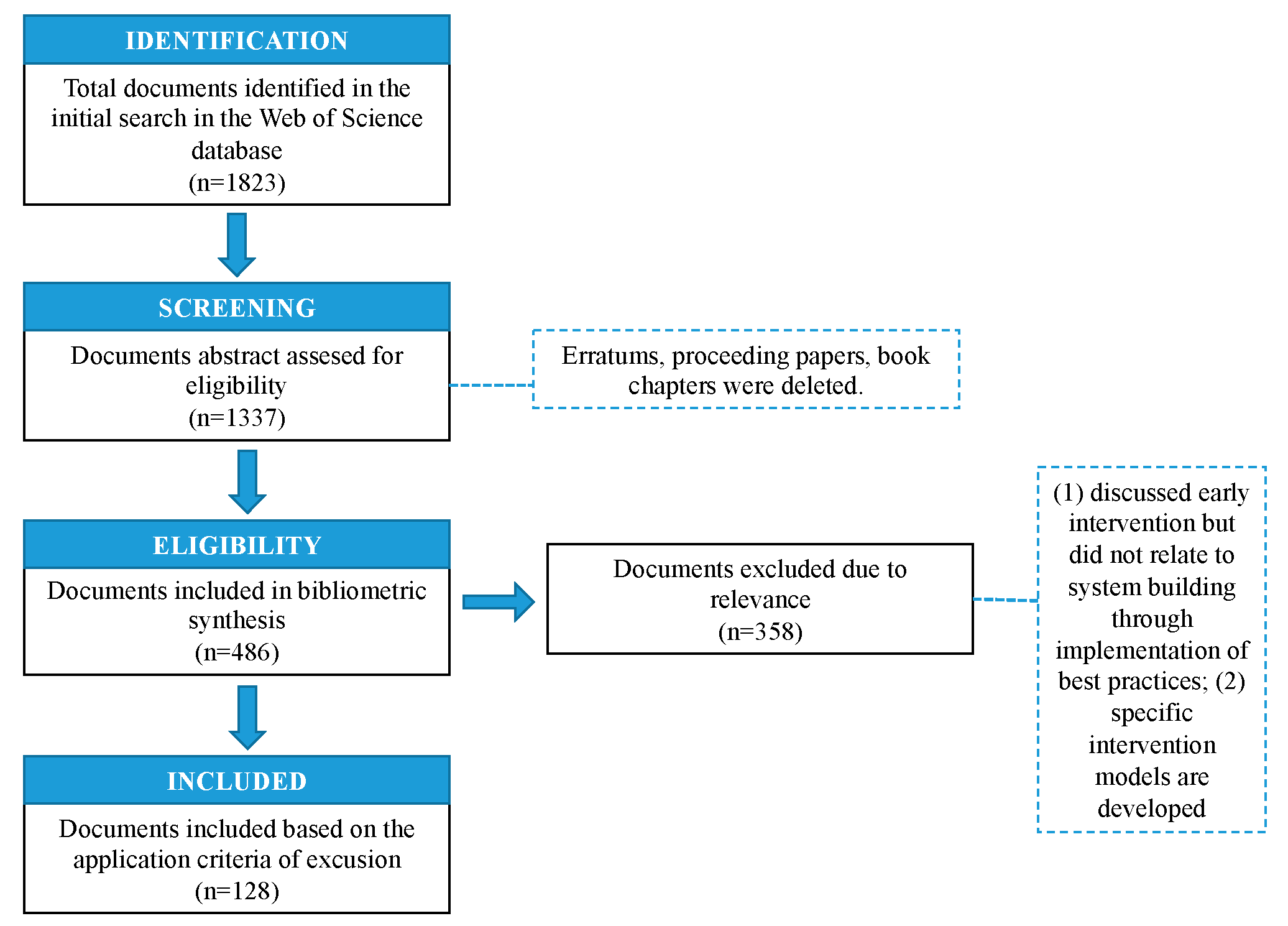
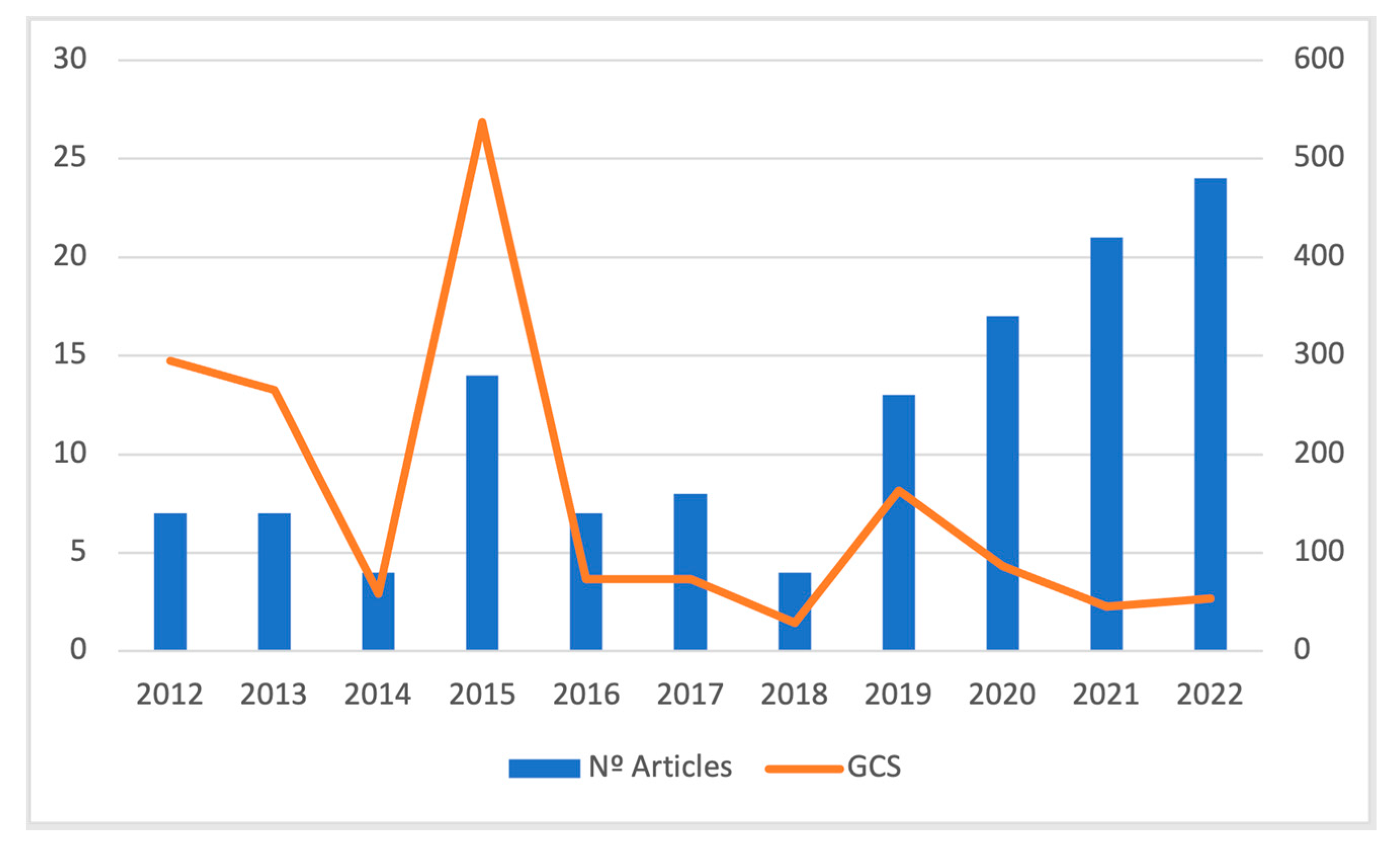
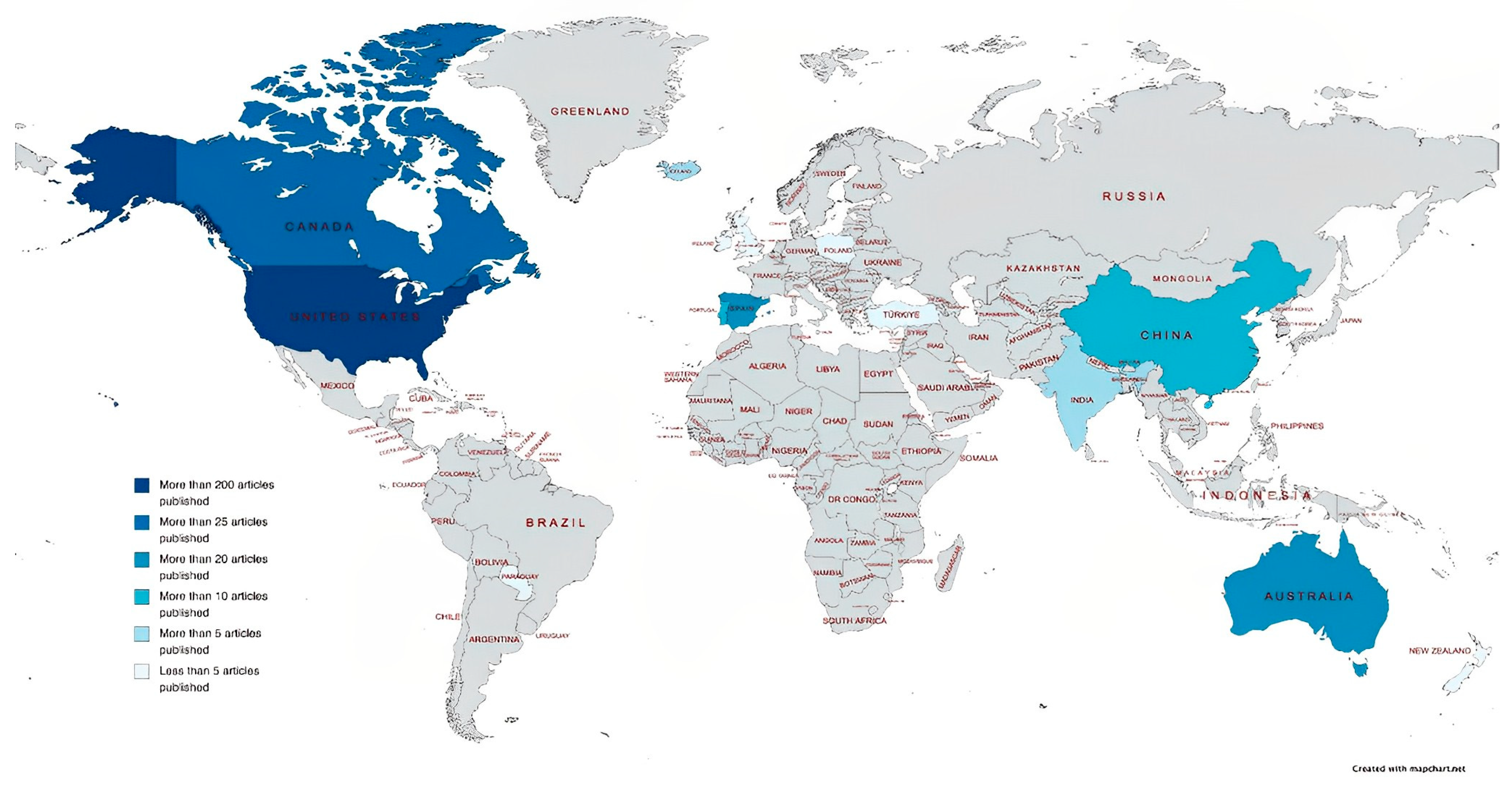

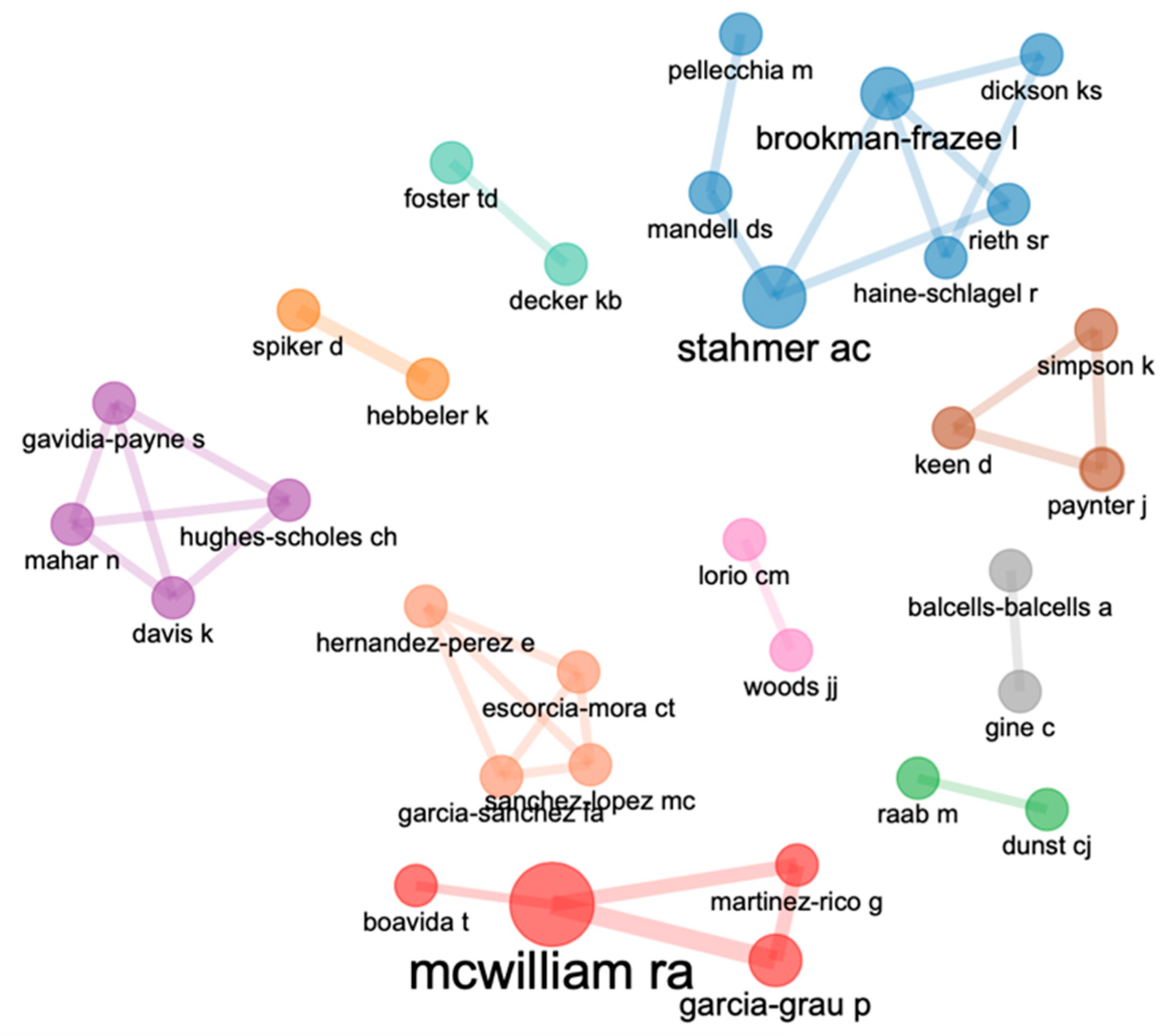
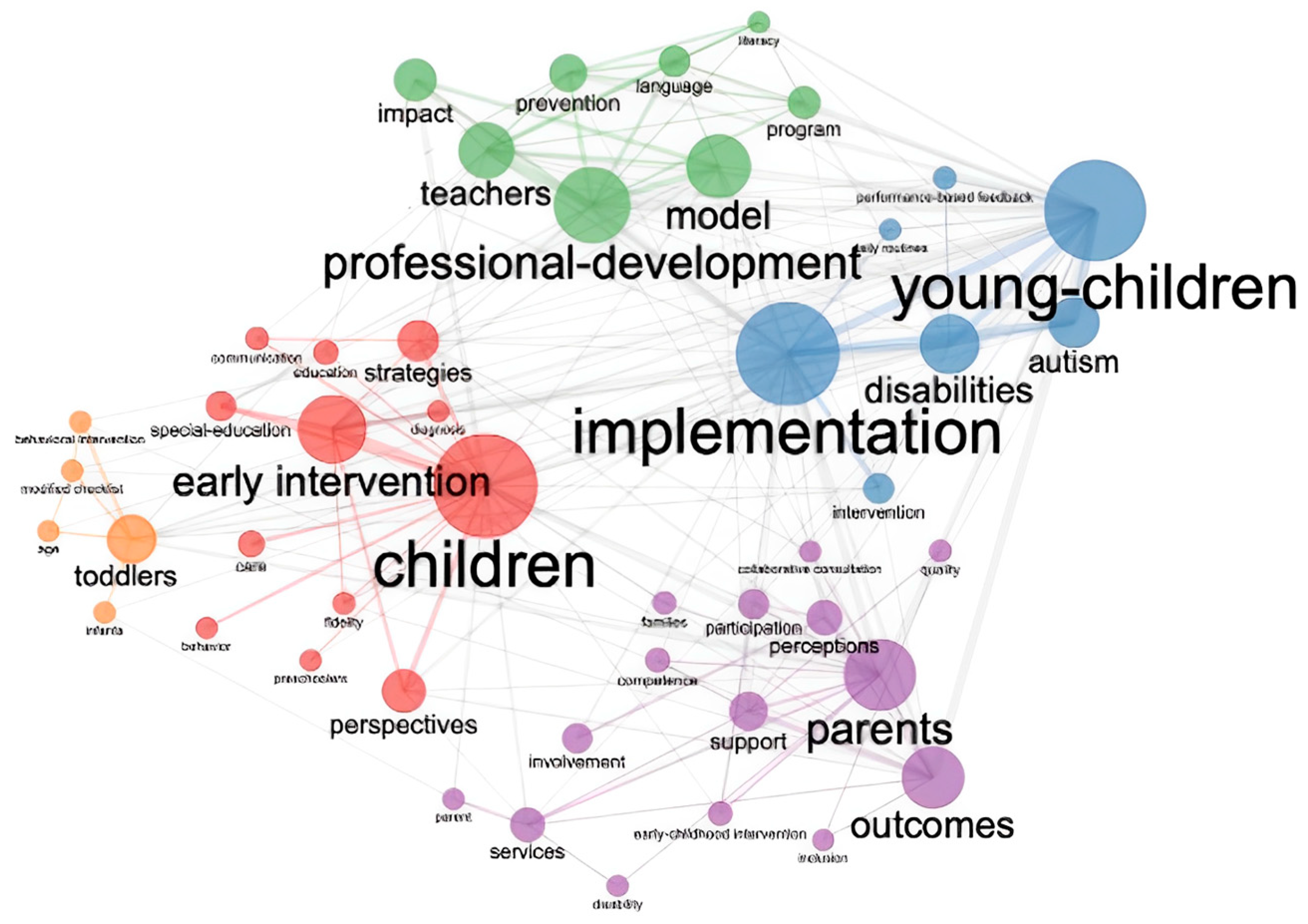
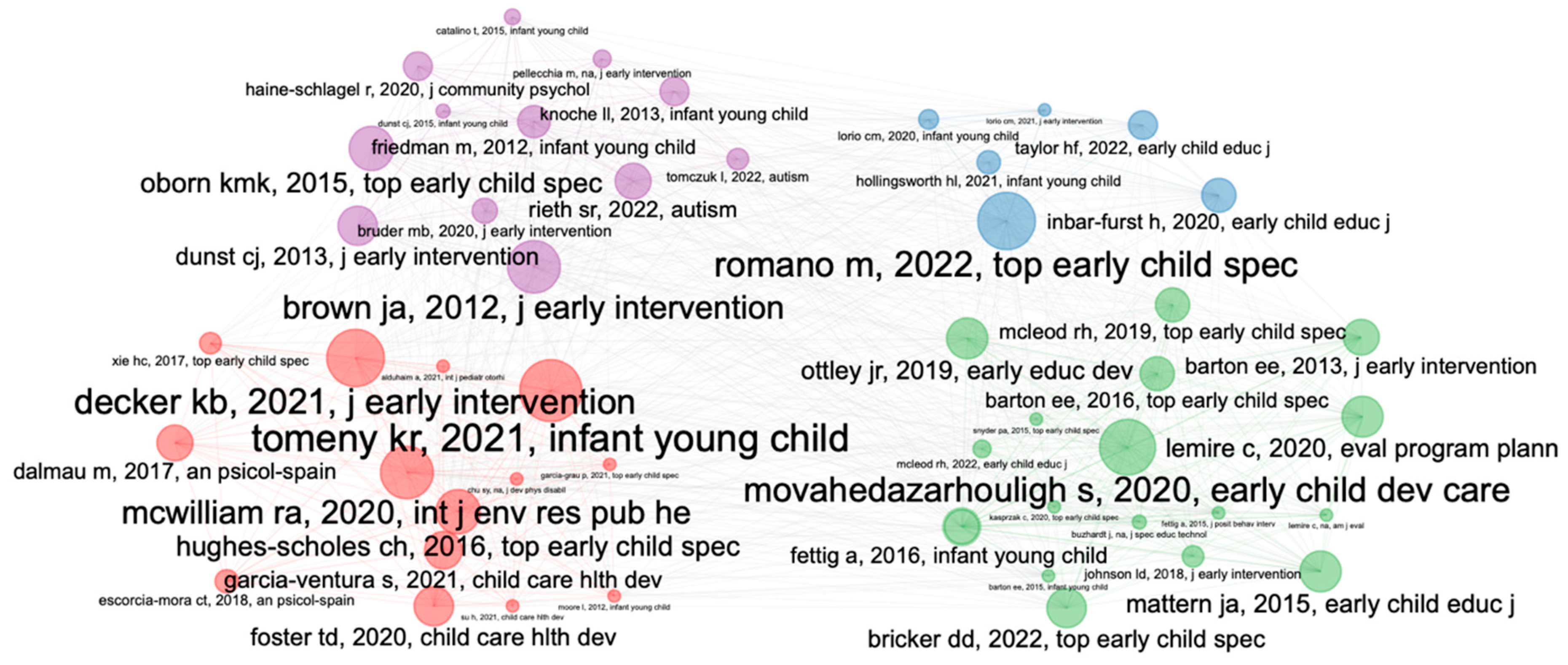
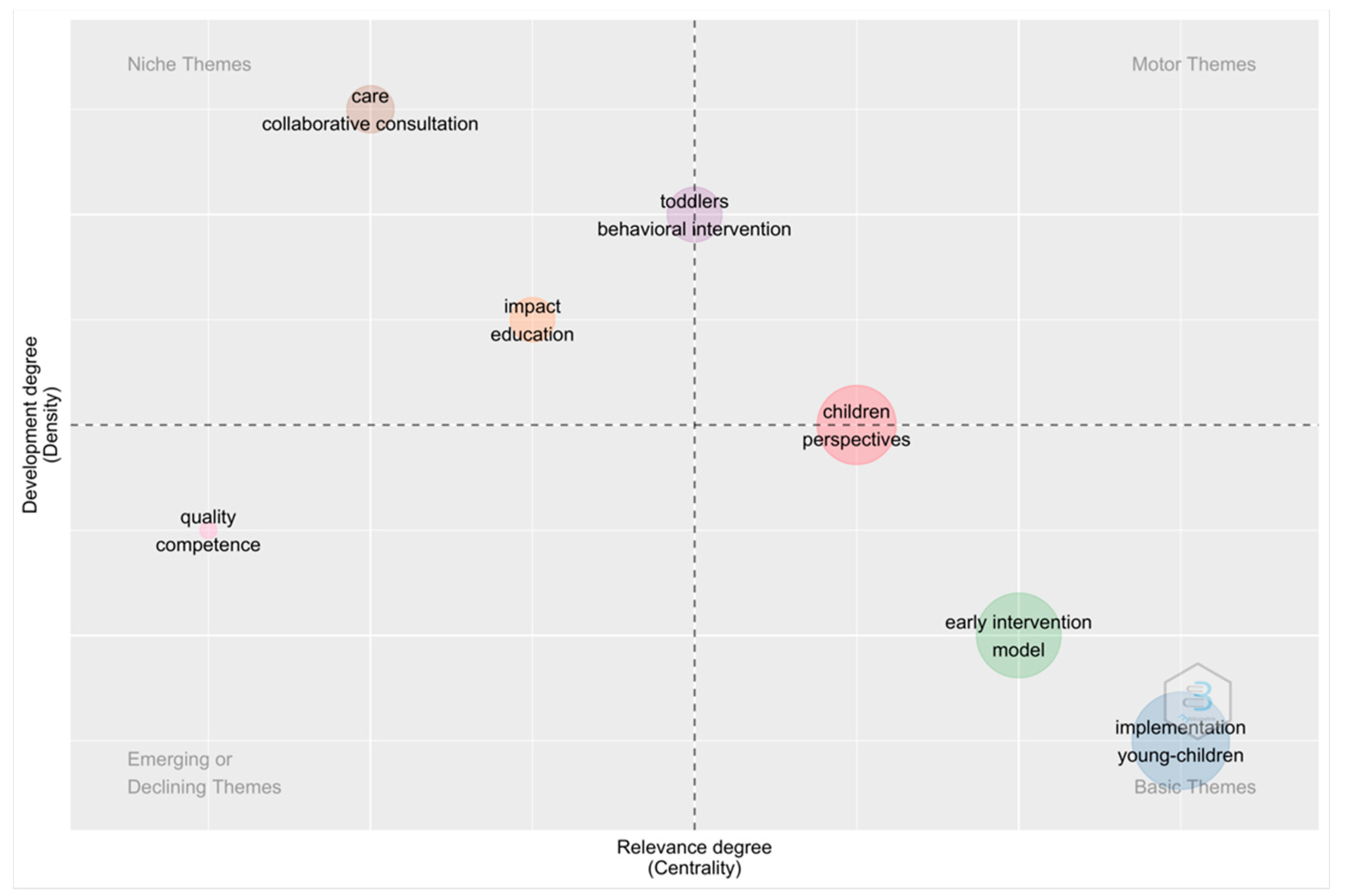
| Main Information about the Data | |
|---|---|
| Journals | 49 |
| Articles | 128 |
| Average citations per document | 13.11 |
| References | 4454 |
| Keywords Plus (ID) | 318 |
| Author’s Keywords (DE) | 379 |
| Authors | 428 |
| Authors of single-authored documents | 10 |
| Authors of multi-authored documents | 418 |
| Countries | 17 |
| Documents per Author | 0.29 |
| Authors per Document | 3.34 |
| Co-Authors per Documents | 4.11 |
| Collaboration Index | 3.54 |
| Author | Nb | Institution | LCS | GCS | GCS/Nb |
|---|---|---|---|---|---|
| McWilliam, RA | 7 | University of Alabama | 3 | 41 | 5.85 |
| Stahmer, AC | 6 | University of California, Davis | 8 | 184 | 30.67 |
| Barton, EE | 5 | Vanderbilt University | 6 | 71 | 14.2 |
| Snyder, PA | 4 | University of Florida | 15 | 226 | 56.5 |
| Dunst, CJ | 4 | Orelena Hawks Puckett Institute | 13 | 102 | 25.5 |
| García-Grau, P | 4 | Catholic University of Valencia | 0 | 27 | 6.75 |
| Mandell, DS | 4 | University of Pennsylvania | 5 | 150 | 37.5 |
| Schnurr, M | 4 | Iowa State University | 0 | 22 | 5.5 |
| Brookman-Frazee, L | 3 | The University of California San Diego | 3 | 43 | 14.33 |
| Carter, AS | 3 | University of Massachusetts System | 0 | 22 | 7.33 |
| 428 authors | - | - | - | - |
| Journal | Nb | LCS | GCS | GCS/Nb | JIF (2021) |
|---|---|---|---|---|---|
| Infants & Young Children | 18 | 40 | 315 | 17.5 | 1.125 |
| Topics in Early Childhood Special Education | 15 | 22 | 298 | 19.87 | 2.313 |
| Journal of Early Intervention | 13 | 14 | 189 | 14.54 | 1.925 |
| Autism | 8 | 7 | 71 | 8.87 | 6.684 |
| Early Childhood Education Journal | 7 | 3 | 26 | 3.71 | 1.656 |
| Child Care Health and Development | 6 | 0 | 36 | 6 | 2.943 |
| Journal of Autism and Developmental Disorders | 5 | 1 | 188 | 37 | 4.345 |
| International Journal of Disability Development and Education | 4 | 0 | 4 | 1 | 1.300 |
| Anales de Psicología | 3 | 4 | 34 | 11.33 | 2.325 |
| American Journal of Evaluation | 2 | 0 | 26 | 13 | 1.507 |
| 49 journals | - | - | - | - |
Disclaimer/Publisher’s Note: The statements, opinions and data contained in all publications are solely those of the individual author(s) and contributor(s) and not of MDPI and/or the editor(s). MDPI and/or the editor(s) disclaim responsibility for any injury to people or property resulting from any ideas, methods, instructions or products referred to in the content. |
© 2023 by the authors. Licensee MDPI, Basel, Switzerland. This article is an open access article distributed under the terms and conditions of the Creative Commons Attribution (CC BY) license (https://creativecommons.org/licenses/by/4.0/).
Share and Cite
Argente, J.; Martínez-Rico, G.; González-García, R.J.; Cañadas, M. Bibliometric Analysis on the Implementation of Evidence-Based Practices through Building Effective Systems. Children 2023, 10, 813. https://doi.org/10.3390/children10050813
Argente J, Martínez-Rico G, González-García RJ, Cañadas M. Bibliometric Analysis on the Implementation of Evidence-Based Practices through Building Effective Systems. Children. 2023; 10(5):813. https://doi.org/10.3390/children10050813
Chicago/Turabian StyleArgente, Julia, Gabriel Martínez-Rico, Rómulo J. González-García, and Margarita Cañadas. 2023. "Bibliometric Analysis on the Implementation of Evidence-Based Practices through Building Effective Systems" Children 10, no. 5: 813. https://doi.org/10.3390/children10050813
APA StyleArgente, J., Martínez-Rico, G., González-García, R. J., & Cañadas, M. (2023). Bibliometric Analysis on the Implementation of Evidence-Based Practices through Building Effective Systems. Children, 10(5), 813. https://doi.org/10.3390/children10050813







